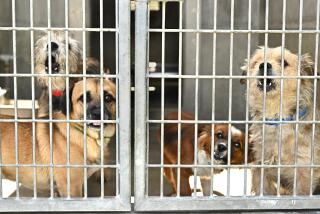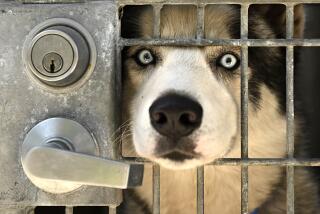Animal shelters improving, officials say, but activists call conditions inhumane

City controller’s audit of animal shelters finds that Los Angeles is still far from a “no kill” city.
The running battle over the treatment of dogs and cats in government-run shelters in the Los Angeles area has produced a mixed, intensely disputed record of reform and has left animal rights activists and many city and county officials at odds.
The tension was on display again Thursday as advocates and local leaders weighed in with a series of new and conflicting reports and complaints.
------------
FOR THE RECORD
Animal shelters: In the Sept. 4 California section, an article about two animal shelter systems operated separately by Los Angeles city and county governments did not sufficiently distinguish some of the comments and complaints made about the different agencies. A Los Angeles city controller audit that gave generally good marks for the reliability of data on animals impounded, adopted or killed dealt solely with the city-run shelter system. A report by animal rights activists criticizing kennel conditions and the handling of shelter dogs and cats was focused on the county Department of Animal Care and Control’s system.
------------
------------
FOR THE RECORD:
Animal shelters: In the Sept. 4 California section, an article about animal shelters operated separately by Los Angeles city and county cited a survey that animal rights activists said included responses from 47 rescue workers and others who had visited county-run shelters. The number provided was incorrect. Eighty-two people responded to the survey, a spokesperson for the group said.
------------
Los Angeles County administrators released a new review defending the operation of the county’s six shelters on the same day that animal rescuers held a news conference highlighting what they say are inhumane conditions in the facilities.
Meanwhile, Los Angeles City Controller Ron Galperin and other city officials gathered at a city shelter to praise the progress made in reducing the number of euthanizations, but voiced their concern that roughly one out of four animals entering the facilities was put to death last year. And the fate of dogs and cats depends, in part, on the shelter, Galperin said.
“Until we get to the point where this is a no-kill zone, then we will not stop” seeking improvements to the system, City Council President Herb Wesson said.
The county inquiry was ordered by the Board of Supervisors last month after local animal welfare advocate Laura Jones posted photos online of dogs lying in feces-encrusted enclosures at a Downey facility.
The report, prepared jointly by the county’s chief executive office and the Department of Animal Care and Control, said the conditions documented by Jones were the result of short staffing and kennel facilities that are “of poor quality and very difficult to maintain.” Staffing schedules at the Downey shelter have been adjusted to ensure kennels are regularly cleaned and the department is recruiting more volunteers and workers through a state job training program, the report added. The kennels at the Downey facility are scheduled to be replaced this year with more modern enclosures.
Inspectors will conduct unannounced visits to each of the county shelters, the report said. Officials are also pursuing unspecified “corrective action” involving an employee who allegedly posted photographs of dead animals on Instagram.
However, Jones and other advocates want a broader investigation of the county animal welfare agency by a civil grand jury or other outside body. They also called for the removal of the department’s director, Marcia Mayeda. At a news conference Thursday, they released results of an online survey of rescue groups concerning conditions in the county shelters, along with photographs of some of the animals whose treatment was the subject of complaints detailed in the survey.
Among the 111 complaints received from 47 survey respondents were allegations of animals being kept in unsanitary conditions, given inadequate medical care and being euthanized after nonprofit rescue groups — or the animals’ owners — tried to claim them, Jones said.
In one 2011 case, Jones said, a rescuer took an elderly poodle from the Carson shelter and found the dog covered in urine and feces and her genitals infested with maggots. The dog was so severely infected that she had to be euthanized.
In another instance, Jones said, a pit bull that had escaped from his owner’s yard and ended up at the Downey shelter in July was killed despite the owner having tried repeatedly to reclaim him.
Cheryl Burnett, a spokeswoman for Supervisor Don Knabe, who represents Downey, said aides to the supervisor met with Jones and will review the survey of animal rescuers and the county investigation. “The information will be used to increase accountability within our shelters and ensure that safety, service and care are improved,” she said.
Mayeda said that the department is following up on each case identified in the advocates’ report, but that it was too early to comment on specifics.
She provided copies of letters from large animal welfare groups expressing support for her department and asking supervisors to give it more funding. One of those, from the American Society for the Prevention of Cruelty to Animals, said Mayeda “has shown a keen willingness to partner with local and national organizations” and as a result “we have seen a notable increase in lives saved.”
Euthanasia rates at the county shelters have decreased over the last few years, particularly for dogs. But about half of the animals brought to the facilities are still euthanized, and more than 70% of cats were killed last year.
Meanwhile, in a new audit released Thursday, Galperin generally gave good marks to the department on an issue that had been the focus of critics: the reliability of numbers the Animal Services Department regularly provides on animals are impounded, adopted or killed. He called the data “reasonably accurate.”
Some information about what happened to animals was mistakenly duplicated or miscategorized, but the errors affected only a small fraction of records, the audit found.
The department undercounted the number of surgeries it performed to spay and neuter animals. And Los Angeles fails to publicly report some types of data that are provided by other animal welfare organizations, making it more difficult to compare the performance of the animal services department with other agencies, the audit said.
Galperin recommended that the city publish more detailed statistics, including the age and health conditions of shelter animals, and adopt better procedures to ensure the accuracy of data the city animal service department releases.
At a news conference Thursday, city officials said the number of animals killed has fallen by more than half since 2003 to roughly 14,000 last year.
Some shelter animals are euthanized due to medical problems or aggression, but the biggest group to be killed in the 2013-14 budget year were newborn kittens, who officials say need round-the-clock care that shelters struggle to provide. In addition, more than 1,600 animals were killed that year because shelters ran out of space.
Galperin also pointed out that the fate of animals seems to rest, in part, on the shelter. The West Los Angeles shelter euthanized 14% of animals it took in, while the South Los Angeles shelter put nearly 37% of its animals to death, he told reporters.
Animal Services Department manager Brenda Barnette welcomed the audit recommendations and said new software would help the department detect errors. Larry Gross, vice president of the Board of Animal Services Commissioners, said the audit was useful in light of persistent skepticism over the statistics.
“At least this audit hopefully puts that to rest — that there are some problems, but generally the numbers are right,” Gross said.
But Daniel Guss, a critic of the department who runs a spay and neuter program, said the audit “leaves a lot to be desired.” He complained that the report neglected bigger issues such as lack of city follow-up on what becomes of animals that are turned over to some rescue groups that partner with the city.
Follow @LATimesEmily and @sewella for breaking news on local government
More to Read
Start your day right
Sign up for Essential California for news, features and recommendations from the L.A. Times and beyond in your inbox six days a week.
You may occasionally receive promotional content from the Los Angeles Times.








